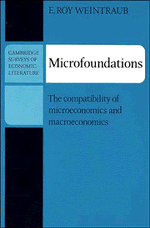2 - Development of the neo-Walrasian program 1930–60
Published online by Cambridge University Press: 03 May 2011
Summary
“in reality the economic system is a whole of which all the parts are connected and react on each other … It seems, therefore, as if, for a complete and rigorous solution of the problems relative to some parts of the economic system, it were indispensable to take the entire system into consideration. But this would surpass the powers of mathematical analysis and of our practical methods of calculation”
[Cournot, 1838, p. 198].The precursors: equilibrium
Although Cournot's insight remained largely unexplored until Walras, the modern developments of the theory probably proceed from Gustav Cassel. In his Theory of the Social Economy he set out in a tractable form a simplified Walrasian system and noted that “the pricing problem is essentially a single problem extending over the whole of the exchange economy and [this fact] gives the pricing prices process an intrinsic consistency which can only be expressed by a system of simultaneous equations” [Cassell, 1932, p. 148].
The analysis was straightforward even by modern standards although the mathematics was used more to achieve expositional clarity than to uncover new features of the system. It was as if economists had to agree on the modelling procedures, the structure of the problem, before mathematical analysis could be utilized.
- Type
- Chapter
- Information
- MicrofoundationsThe Compatibility of Microeconomics and Macroeconomics, pp. 19 - 37Publisher: Cambridge University PressPrint publication year: 1979



